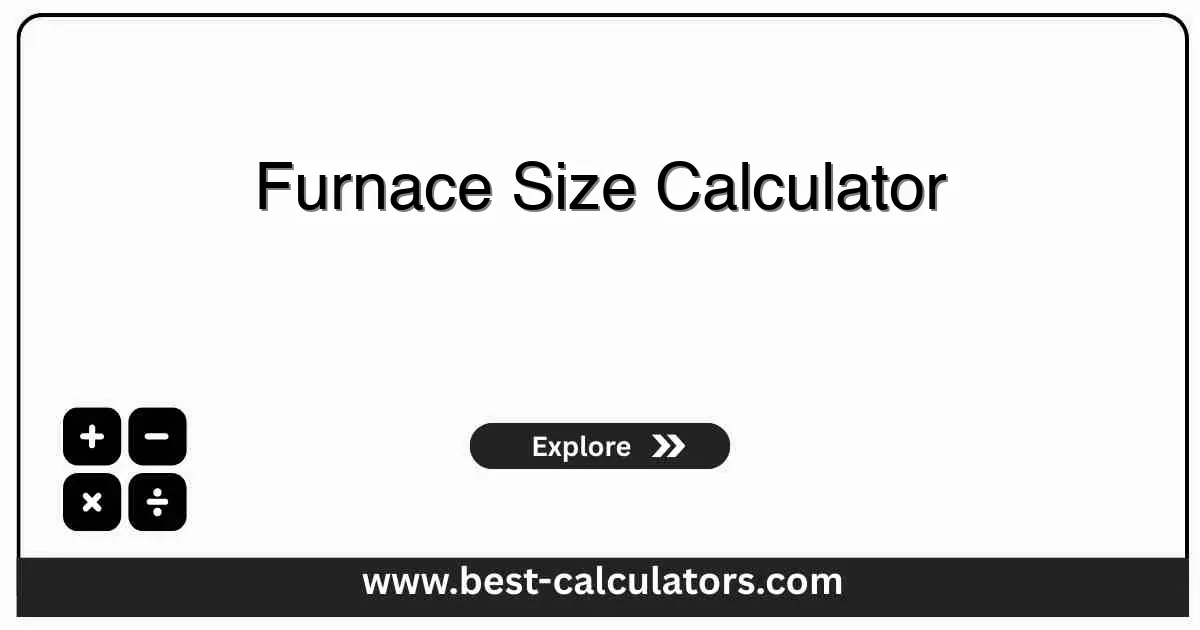Furnace Size Calculator - Calculate Required BTUs
Determine the correct furnace size for your home to ensure efficient heating, lower energy bills, and optimal comfort in your specific climate zone.
Home Details
Results
What is a Furnace Size Calculator?
A Furnace Size Calculator is a vital tool for homeowners and HVAC professionals to estimate the heating capacity required to keep a home comfortable. Capacity is measured in British Thermal Units (BTUs).
Sizing your furnace correctly is critical. A system that is too small will run constantly and fail to heat your home on the coldest days. A system that is too large will cycle on and off rapidly ("short cycling"), causing temperature swings, wear on parts, and wasted fuel.
This tool evaluates:
- Square Footage: The volume of air that needs to be heated.
- Climate Zone: The severity of winters in your geographic location.
- Insulation: The efficiency of your home's thermal envelope.
To determine the cooling needs for your home during summer, use our Air Conditioner BTU Calculator.
For sizing a boiler system instead of a forced-air furnace, check out our specialized Boiler Size Calculator.
If you are upgrading ventilation to improve indoor air quality, our Air Changes per Hour Calculator is essential.
For estimating the operating costs of your electric heating system, try the Electricity Cost Calculator.
To compare the cost efficiency of different heating fuel types, use the Electric vs Gas Appliance Calculator.
How It Works
The calculation uses a standard HVAC estimation formula:
Variables explained:
- Climate Factor: Ranges from 30 BTU/sq ft (Hot, e.g., Florida) to 60+ BTU/sq ft (Very Cold, e.g., Minnesota).
- Insulation Factor: A multiplier to adjust for heat loss. Poor insulation increases the need by ~10%, while good insulation reduces it by ~10%.
- Efficiency (AFUE): To get the Output BTUs, we divide by the furnace efficiency (e.g., 0.80 or 0.95) to find the required Input BTUs rating found on furnace labels.
Key Concepts Explained
BTU
British Thermal Unit. The energy needed to heat 1 lb of water by 1°F. Standard measure of heating power.
AFUE
Annual Fuel Utilization Efficiency. A 90% AFUE furnace wastes only 10% of fuel, requiring lower input BTUs.
Heat Load
The total heat energy your house loses in an hour that the furnace must replace.
Short Cycling
When a furnace turns on and off rapidly because it heats too fast. Bad for efficiency and comfort.
How to Use This Calculator
Enter Area
Input the total square footage of the living space you need to heat. Exclude unheated garages.
Select Climate
Choose the climate zone that best matches your location (Hot, Moderate, Cold, Very Cold).
Rate Insulation
Select Good, Average, or Poor based on your windows and wall insulation.
Get Size
View the recommended Output BTUs and Input BTUs for different furnace models.
Benefits of Proper Sizing
- • Optimal Comfort: Maintains a steady, consistent temperature throughout your home.
- • Lower Energy Bills: Runs at peak efficiency without wasting fuel on start-up/shut-down cycles.
- • Extended Lifespan: Reduces stress on the blower motor and heat exchanger, making equipment last longer.
- • Quieter Operation: Avoids the noise of constant high-speed air blasts associated with oversized units.
Factors Affecting Your Results
Windows
Large or single-pane windows are major sources of heat loss. Homes with many windows need more BTUs.
Ceiling Height
Standard calculations assume 8ft ceilings. If you have 10-12ft ceilings, increase the BTU estimate by 10-20%.
Sun Exposure
South-facing homes gain free solar heat, potentially lowering heating needs, while shaded homes need more.

Frequently Asked Questions (FAQ)
Q: How many BTUs do I need for my house?
A: A general rule of thumb is to multiply your home's square footage by a climate factor ranging from 30 to 60 BTUs. For a 2,000 sq ft home in a moderate climate (40-45 BTUs/sq ft), you would need approximately 80,000 to 90,000 BTUs.
Q: What happens if my furnace is too big?
A: An oversized furnace will heat your home too quickly and shut off, a process called "short cycling." This leads to uneven temperatures, increased wear and tear on components, and higher energy bills.
Q: What happens if my furnace is too small?
A: An undersized furnace will run continuously on cold days without ever reaching your thermostat's set temperature. This causes discomfort and puts excessive strain on the system.
Q: What is AFUE and why does it matter?
A: AFUE (Annual Fuel Utilization Efficiency) measures how efficiently a furnace converts fuel to heat. A 90% AFUE furnace converts 90% of fuel to heat. Higher AFUE means lower fuel costs.
Q: Does insulation affect furnace size?
A: Yes, significantly. A well-insulated, airtight home retains heat much better than a drafty one, allowing for a smaller, more efficient furnace system. Poor insulation increases your heat load.